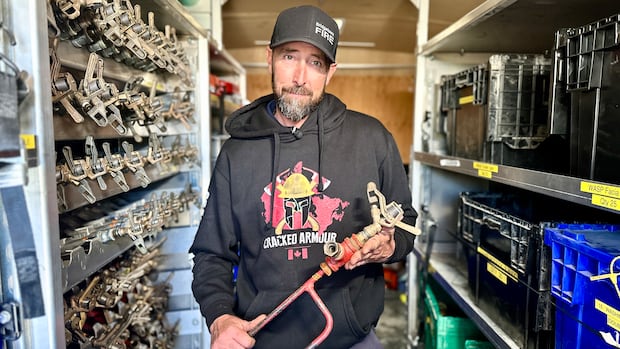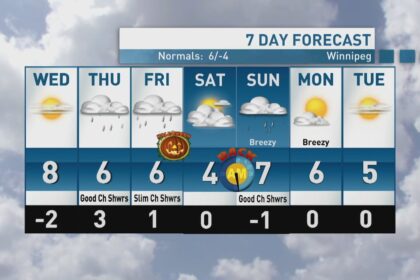Nova ScotiaAs two major wildfires raged in Nova Scotia, hundreds of sprinklers were hard at work protecting homes and critical infrastructure. The operations were so effective that the province is buying more.N.S. to buy more sprinklers after effective season fighting two major wildfiresAly Thomson · CBC News · Posted: Oct 21, 2025 5:00 AM EDT | Last Updated: 2 hours agoHow sprinklers help save homes from wildfiresAs two major wildfires raged in Nova Scotia this summer, hundreds of sprinklers were hard at work protecting homes and critical infrastructure. The operations were so effective that the province is buying more. Aly Thomson tells us more.A generator is buzzing at the operations site of the Lake George wildfire in Nova Scotia as a crew member spreads out countless lengths of hose to dry in the sun.The lines have just been pulled from homes and infrastructure, where they were feeding hundreds of sprinklers with water that shot into the air and kept homes damp, saving them from approaching flames and falling embers.With that Kings County wildfire under control, the equipment is being packed into trailers until the next time it’s needed.This wildfire season saw the biggest operation in the province’s history to protect structures. The measures were so effective that the Department of Emergency Management is buying more structure protection units — the trailers that contain all the needed equipment such as sprinklers, pumps and hoses.Sprinklers helped spare dozens of homes and infrastructure during both the Lake George and Long Lake wildfires, said Rockwood.They work to protect structures by wetting surfaces to prevent ignition from embers and by cooling the environment to slow fire progression.Nova Scotia currently owns one wildfire structure protection unit but also has partnerships with local fire departments who own their own units. (Aly Thomson/CBC)At Lake George, 600 sprinklers of various designs were employed. It took about five days to set up and weeks of labour to keep running.“It’s been very time-consuming but very effective,” said Dave Rockwood, the province’s fire and ground search and rescue co-ordinator, a new position with the Department of Emergency Management.Nova Scotia currently owns one structure protection unit. The province said it plans to buy additional units at $245,000 each, although it would not say exactly how many.It noted it also has partnerships with local fire departments across the province who have their own units, such as Halifax Regional Fire and Emergency and the Brooklyn Volunteer Fire Department.During the Long Lake fire in Annapolis County, 88 homes were fitted with sprinklers, and 85 of those homes were saved, the province said.“Three were unfortunately unable to be saved because of the topography around those homes, and other factors. Fuel types and fire types will differ every time, and will contribute to the outcome,” said provincial spokesperson Patricia Jreige in an email.“Other things like the layout of the community and construction materials of structures also make a big difference in the outcome when using sprinklers.”During the Lake George wildfire, about 600 sprinklers were set up on homes and around the community. (Province of Nova Scotia)A total of 20 homes were lost. But Jason Burton’s was not one of them.His house was outfitted with sprinklers and managed to stay standing. Steps away, his garage burnt to the ground.“I truly appreciate everything they did,” Burton said in a recent interview, becoming emotional. “I want to thank you so much.”Sprinklers were also set up on infrastructure such as bridges and at strategic locations around the community during the wildfire near Lake George. (Province of Nova Scotia)During the Lake George fire, sprinklers were also set up throughout the area to create a force field of water, said Rockwood.“So around each community, we’d put sprinklers every 25 feet. The sprinklers shoot about 30 feet. So we’d get a crossover and we just created a wall of water around each of the little subdivisions,” Rockwood said in a recent interview.Keeping the sprinklers running is a massive operation. Crews have two options: if there’s a water source nearby, they can pump water from there to feed hose lines directly. If not, they have to bring in large portable tanks.Rockwood said one portable water tank holds 2,500 gallons — roughly 10,000 litres — of water and will drain in 30 to 45 minutes. Dave Rockwood, Nova Scotia’s fire and ground search and rescue co-ordinator, lays out lengths of hose to dry in the sun at the operations site of the Lake George wildfire. (Aly Thomson/CBC)That means engines have to run back and forth between a water source and the tank constantly throughout their shift, topping it up to keep the sprinklers running.“During Long Lake, we moved millions and millions of gallons,” said Rockwood.“We were able to locate smaller ponds, but in people’s yards, that kind of thing. But a lot of them were already empty. So then we still had to bring it up and it was taking 80 tankers just to fill some of these ponds so we’d have reliable water sources on site,” he said.Rockwood noted sprinklers were not used during the devastating Halifax-area and Shelburne County wildfires in May 2023 because those fires were moving much too fast, which is typical fire behaviour early in the season.The province said the new structure protection units will be purchased through the province’s regular procurement process.MORE TOP STORIESABOUT THE AUTHORAly Thomson is an award-winning journalist based in Halifax who loves helping the people of her home province tell their stories. She is particularly interested in issues surrounding women’s health, justice, education and the entertainment industry. You can email her with tips and feedback at aly.thomson@cbc.ca.
Wall of water’: How sprinklers are saving homes from wildfires











